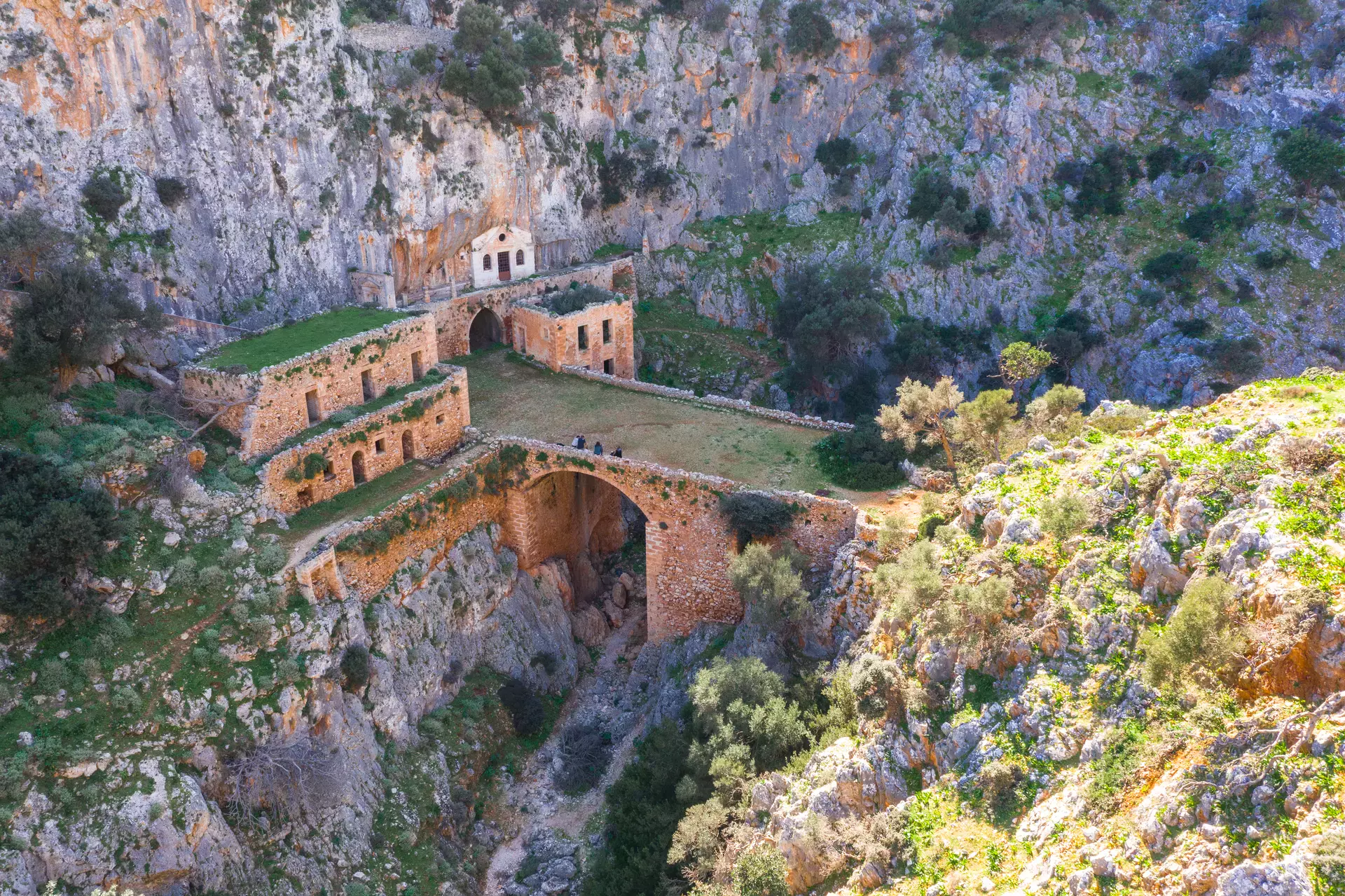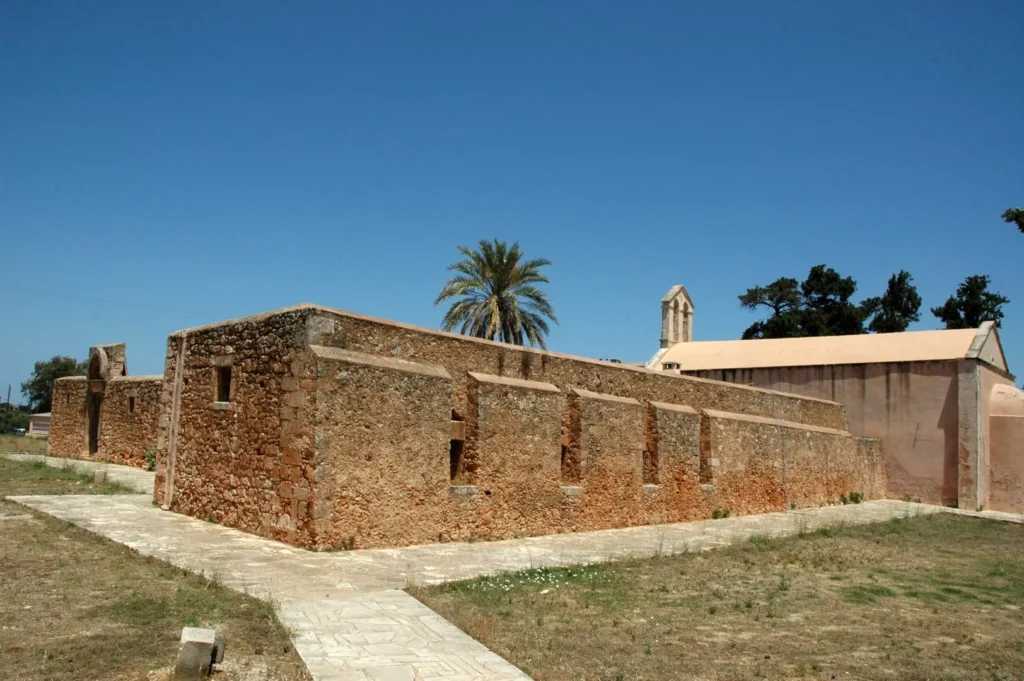The luxurious villa “Afeidia” is located in the area of Kafkala-Mahairida, 2, 5 km away from the village Chorafakia, in the northwest part of the Municipality of Akrotiri. It was named after the abundance of biodiversity and the natural beauty that surround it.




The cave of Saint John the Hermit or Xenos in Avlaki Gorge, in north Akrotiri, is located just a few hundred meters away from the monastery Gouverneto and next to the abandoned Katholiko Monastery.
Similar to Cave Arkoudospilios this was a riverbed with a total length of about 135 meters, forming a horizontal room. Its rich decoration is characterized by large stalactites and stalagmites. Inside the cave, at the beginning and the end of the cave, there are icons and candles. There is also a carved underground tank with coating, created to collect water.
To the right of the tunnel, 15 meters from the entrance, there is a small room with an artificial entrance, where some human bones have been found, probably belonging to a hermit. At the end of the cave, at 135m in length, there is a big stone basin, which is told to have been the tomb of Saint John the Hermit. In this last room, there are also several inscriptions of travelers, engraved on the walls and stalactites, some of which are very old.
https://www.cretanbeaches.com/en/caves/saint-john-the-hermit-cave-akrotiri

East of Stavros, at Akrotiri, starts the well-marked path that crosses the small gorge of Mavre and was for many centuries the main route passing through the wild and rugged mountains of Akrotiri to link the villages of the fertile planes to the hermitages of the barren rocky mounts.
This seemingly barren and inhospitable landscape was a haven for hermits and is full of hidden treasures that are not visible at first glance. One of the many small convents surviving today is that of Saint George Apidiotis located in the gorge of Mavre. The austere temple is built in one of the many caves of Akrotiri and has a nice view of the ravine.
https://www.cretanbeaches.com/en/religious-monuments-on-crete/inactive-monasteries-and-hermitages/monasterial-monuments-of-kydonia-province/church-of-saint-george-apidiotis-at-akrotiri

Catholic monastery is located in the mountainous area Arkoudovounia, 20km east of Chania, near the northern shores of Akrotiri Meleha. It is located inside the gorge Avlaki, at a short distance from the sea.
It can be accessed through a stepped and carved cobbled path that starts from the monastery Gouverneto, passes near the church of Saint Anthony (Agios Antonios), from the Cave of Panagia Arkoudiotissa, and ends at the monastery Katholiko.
If you keep walking to the sea, you will find yourself in a wonderful small fjord with turquoise waters, where there are the ruins of the old harbor of the monastery. The monastery complex was founded at the site of the cave where Saint John the Hermit or Xenos died during the 11th century. After the death of Saint John the Hermit, this wider inaccessible area known as Arkoudovounia became one of the most important ascetic centers in Crete.
The cave was turned into a temple (it celebrates on September 20) and the surrounding cavities were originally a refuge for the hermits, while later some monk cells were also built. In the 17th century, in front of the cave, extensive construction of buildings took place under the supervision of Jeremiah Tzagarolo and with architectural drawings from the works of Sebastiano Serlio, and thus the monastic complex acquired its current impressive form.
You can even see the ruined cells of the hermits, the bell tower, and the impressive bridge that crosses the river of the gorge, creating a large square that connects the two sides. At the foot of the bridge, there are large vaulted storage spaces, while on both sides a two-story building and a small series of vaulted rooms were built to house the pilgrims.
The cult of Agios Ioannis spread so much in the wider area of Chania, that according to the census of 1637 the income from the pilgrims was one of the largest. This fact is very important, especially if one considers the strenuous course that the visitors had to hike then to approach Katholiko. When the shores of Crete became the target of the pirates, fear prevailed, the monastery was deserted and the monks were forced to move to a more secluded place and thus retired to the monastery Gouverneto.
At the exit of the gorge to the sea, there is a large rock in a shape reminiscent of a ship and, according to legend, it is a pirate ship that was stoned after the curses of the abbot of Katholiko.
https://www.cretanbeaches.com/en/religious-monuments-on-crete/inactive-monasteries-and-hermitages/monasterial-monuments-of-kydonia-province/katholiko-monastery-at-akrotiri-gouverneto

The monastery of Saint John the Merciful (Agios Ioannis Eleimon) is located very close to Chania airport, south of the village Pazinos or Gagalado at Akrotiri, and close to the monastery of Agia Triada Tzagaroli; it was its dependency.
The monastery was founded in the 16th century and was fortified; its walls are preserved in excellent condition. The monastery is a rare sample in Greece of western monastic architecture, as the church is built outside the central courtyard, where the chiostro (tunnel) with monk cells is located.
Therefore, the reason it is believed that the Catholic monastery of Saint George (Agios Georgios), which is mentioned in the census of 1637 by Kastrofilakas, was this monastery.
The main church is single-aisled with a pointed arch and is reinforced externally with buttresses. The entrance to the temple for the monks is from the south side, while for the visitors from a gate with a vaulted passage on the west side. To the north of the courtyard is preserved an exceptional specimen of monasterial olive mill, to which has been added a floor that served as an abbey.
https://www.cretanbeaches.com/en/religious-monuments-on-crete/inactive-monasteries-and-hermitages/monasterial-monuments-of-kydonia-province/monastery-of-saint-john-the-merciful-at-pazinos

Gouverneto or Gderneto Monastery is located 19km east of Chania, on the north side of the Cape Akrotiri of Chania, near the monastery of Agia Triada Tzagarolon. It can be accessed through the Agia Triada, where there is a sign leading to the Gouverneto.
It is situated on a rocky site at an altitude of 260m, near the entrance of the gorge Avlaki, and is built with fortress architecture and four towers with bastions protect its corners. The Gouverneto monastery was built before 1537, as proved by an inscription at the entrance of the fortress, being one of the oldest monasteries in Crete.
It is believed that the monastery was founded by hermits and monks of the seaside Katholiko Monastery, who may build the new monastery over a pre-existing ancient temple to protect themselves from pirate raids. The church of the monastery is dedicated to Virgin Mary, so it is also called Kyria ton Agelon (Lady of the Angels Monastery).
It has a cruciform shape with a dome, while the entrance is decorated with relief representations of monsters. It started being built during the Venetian Era, but the construction finished 2.5 centuries later, as the Turks invaded Crete and forbid building Christian temples. Around the church of the monastery, which is located in the center of the courtyard, there are the other buildings of the complex. Among them are 50 monk cells on two floors, the dining room, a small museum, etc.
Also, next to the church there are two chapels dedicated to Agii Deka (Saints Ten) and Saint John the Hermit. St. John the Hermit lived in a cave in the gorge Avlaki, adjacent to the monastery, and is considered the founder of the monastery. You can walk in Avlaki gorge by following the stone-paved trail that descends to the sea. After 20 minutes of descent, you will meet the Arkoudospilio Cave and after a while the ruined monastery Katholiko and the cavernous church of St. John, where the hermit lived. After more than 10 minutes, the gorge ends in a narrow rocky fjord with green waters.
https://www.cretanbeaches.com/en/religious-monuments-on-crete/monasteries-in-crete/gouverneto-monastery

The monastery of Agia Triada of Tzagarolon is one of the richest and most beautiful monasteries in Crete. It is built near the airport of Chania, in the position of Tzobomylos of the Cape Melecha and at the foothills of Stavros Mount. The distance from Chania is only 15km. The monastery was built by the Venetian nobles Jeremiah and Lawrence Tzagarolo.
Jeremiah was a famous scholar of his era with rich education and was a friend of the Patriarch of Alexandria, Meletios Pigas. Jeremiah himself was a candidate for Patriarch of Constantinople. Moreover, Jeremiah designed and built the monastery complex of the monastery, being affected by the architect Sebastiano Serlio from Verona, Italy. The monastery today hosts a small museum with various pictures and icons.
The most important are the 12th-century cloth for covering the altar, the icons of St. John the Theologian (16th century), St. Nicholas (17th century), and the icons of the painter Skordilis: the Enthroned Christ, Living Spring and the Second Coming (1635-1645).
Today, after numerous historical adventures, the monastery continues to play an important role in the religious and economic life of Crete. It is Stavropegic, which means that it is directly managed by the Ecumenical Patriarchate of Constantinople. Visitors will see an incredibly well-preserved and vibrant monastery that produces and exports organic olive oil, wine, honey, vinegar, and olive oil soap of unique quality.
https://www.cretanbeaches.com/en/religious-monuments-on-crete/monasteries-in-crete/monastery-of-agia-triada-tzagaroli

The Monastery of St. John the Baptist is built-in position Korakies of Akrotiri, close to the airport of Chania. It is a historic convent that is relatively unknown in Chania.
The monastery has been destroyed several times by the various conquerors of Crete and thus valuable documents that could help in accurate dating of the monastery foundation were lost. It is believed however that it was initially founded before the Fall of Constantinople (1453) in the coastal area of Agia Kyriaki, in Halepa suburb of Chania.
However, later, when the constant pirate raids of the Arabs started, the nuns moved to a safer place, on the hill of St. Matthew and later they moved to the current position. The monastery is surrounded by a tall wall and its main entrance is minimal, compared with the rest monasteries of Akrotiri.
In the middle of the verdant enclosure, you will see the two-aisled church of St. John the Baptist (celebr. 29 August) and St. George (23 April), surrounded by the humble cells and the rest buildings of the monastery.
The icons of the monastery have been drawn by the nuns. Also, there are the small chapels of St. Andrew the Cretan and Panagia Portaitissa. A remarkable Housekeeping School operated in the monastery, at the current museum position, which immediately gained a great reputation throughout the island. Indeed, the nuns sewed the wedding dress of the Greek Queen, Olga, in 1867.
https://www.cretanbeaches.com/en/religious-monuments-on-crete/monasteries-in-crete/monastery-of-saint-john-baptist-by-korakies